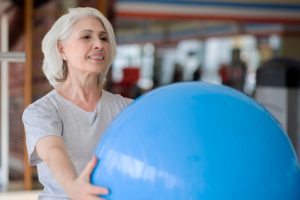A new student in Monday night’s Minding Your Balance class experienced subtle changes in her balance during the centering exercise when she shifted her attention in different directions. The exercise, which teaches students how to find center-of-balance, brings to light the way in which attentional focus leads movement. Sometimes people notice a significant drift of their body in the direction of their attention, for example, leaning back when thinking back, or tilting sideways when moving attention to the side. On the other hand, placing attention at one’s center of balance results in a marked improvement of postural stability. Interestingly, improved stability as well as postural drift occur without any physical effort – the only “work” is in shifting attentional focus.
Shifting attention forward, back, or to the side causes posture to drift in those directions because attention and intention are embedded components of movement control. When my awareness turns to a need or a goal requiring movement, my intention to act initiates that movement. For example, as soon as I see the “Pedestrian Walk” light while waiting to cross the street, my weight shifts forward and I step into the cross walk. Any time I need to get from here to there, be it rising from my chair to greet a friend, turning to reach for the cutting board on the kitchen counter, stepping around the dog under my feet, or answering the front door, my intention to act leads the shifting of my weight in the direction of my goal.
An interesting research study out of Canada asked the question “how and why do elderly people fall?” The researchers placed cameras in common living areas (hallways, sitting room, dining room) of two long-term care facilities. They found that the most frequent cause of falling was incorrect weight shifting in the course of ordinary daily activities. Those ordinary activities included quiet standing, walking forward, and sitting down. The researchers described these as “center of mass” disturbances, as opposed to “base of support” (the feet) disturbances such as tripping or slipping, which occurred less often.
Good balance requires keeping our center of mass safely over our base of support — a dynamic process as we move. The research findings suggest that, as we age, it becomes more common for posture to drift beyond our ability to remain safely over our feet as we shift weight during movement.
The causes of that out-of-control drift are many and include issues such as stiff joints and a loss of strength. While strength and flexibility are critical for maintaining safe postural alignment, recognizing the intrinsic nature of activity of mind in movement control opens the door to another critical element of good balance — mindful awareness.
In the exercise Monday night, the new student not only experienced the powerful impact of centering, she gained insight into the effect of attention on movement and developed a greater awareness of her felt sense of stability and motion. The lessons provide resources for achieving better balance: recognizing the feeling of stable posture and the link between intention and movement allows her to better call upon her ability to be grounded when confronted with challenging circumstances (an uneven sidewalk, a dimly lit room), and the knowledge of how to purposefully stabilize her balance by centering allows her to intentionally take control of her own well-being.
For information about Minding Your Balance programs email balance@denverkiaikido.com or call 720 934-1098.

